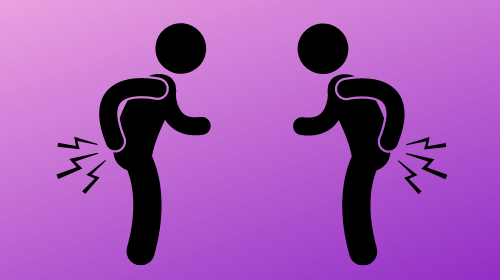Top Tips for Living With Sciatica

At the moment ‘sciatica’ is one of the most common things I am treating in clinic so I’m giving out this advice a lot!
But what is it you ask?
Sciatica is basically pain that is felt anywhere along the sciatic nerve so anywhere from the back of the pelvis and buttock to all the way down the back or outside of the leg or even to the sole of the foot. Pins and needles may also happen too. The most common cause of this that I treat in clinic is the gluteal(buttock) muscles pressing on to the sciatic nerve, as it passes underneath them, causing the nerve to become irritated. There are other causes of sciatic nerve pain but today we’re focusing on this particular cause.
So, here are my top tips for managing sciatic nerve pain yourself
1. STRETCH
The gluteal (buttock) muscles tend to press on to the sciatic nerve when they are contracted or tight so stretching them out can help to relieve that pressure. Here’s a couple of glute stretches that I prescribe most often- lying down, seated 1 and seated 2.
2. BALL ROLLING
Use a massage ball to apply pressure to the sore parts of the gluteal muscles (a tennis ball works just as well if you don’t have a massage ball). This gives a deeper, local stretch to the parts of the muscles that need it and helps the muscles to relax thus relieving the pressure on the sciatic nerve. Lean against the ball and roll around until you find a sore spot, hold the pressure at that point and what until the pain starts to ease, then you can release the position. You can see a video of how to do this here.
3. SLEEP POSITIONS
Sciatic nerve pain can be particularly annoying at night as it can be difficult to find a sleeping position that doesn’t hurt. Using a pillow to prop up different parts of the body can help a lot. If you sleep on your back try placing a pillow under your knees. This raises the knees up and reduces the amount of tension though the sciatic nerve. If you’re a side sleeper try putting a pillow between your knees. This stops the pelvis from rotating towards the bed and pressing the gluteal muscles against the sciatic nerve. Have a look at this video to help with your positioning.
4. HEAT
Heat is great because it can help contracted and tight muscles to relax. You can try putting a warm wheat bag on the area, standing under a hot shower or there’s various warming gels/creams and such like available if you have a chat with your pharmacist.
5. KEEP MOVING
It’s very important that you keep moving as much as you are able to. No, you might not be able to do all of the activities that you normally do but you can still go for a short walk (or a longer walk, it’s up to you and your body). Listen to your body, if the back, buttock or leg start to ache then you know that’s the time to stop and have a little rest and a stretch before carrying on. In this way you may be able to half an hour in 10 minute chunks for example. And it doesn’t have to be a walk, you can use the same principles for any activity- do a bit, stop and stretch as and when you feel you need to and then carry on again when it’s eased off. But whatever you don’t stop altogether as this can cause the body to seize up and end up with other aches and pains which I’m sure you don’t want.
6. SEE YOUR OSTEOPATH
If you’re still suffering from sciatic nerve pain after a couple of weeks then it is a good idea to get it checked out. 1) because they will be able to work more specifically on the affected muscles and joints as well as any other associated postural problems and 2) because they will be able to tell you if there’s a different cause for the sciatic nerve compression rather than simply tight muscles and they will be able to treat and advise accordingly.
So there you are, my top tips for helping you to manage your sciatic nerve pain yourself and a little reminder that you don’t need to suffer in silence if it carries on for longer than you think it should. Have a go and let me know how you get on.
